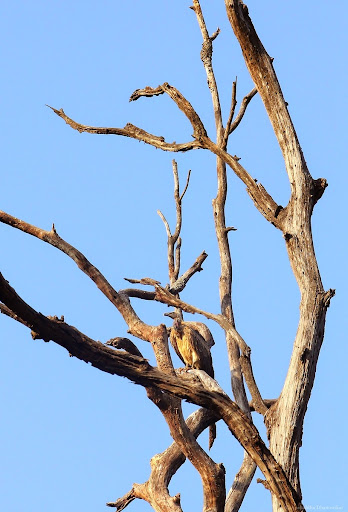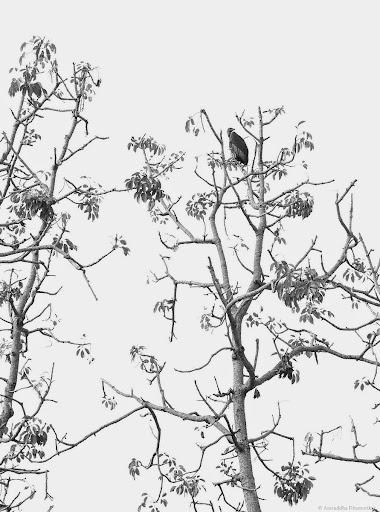The Plight of India's Vultures
First Saturday of September is celebrated as International
Vulture Awareness Day (www.vultureday.org; it was celebrated on September 6, 2014 this year)
to raise awareness concerning vultures, and especially their threateningly
declining numbers. An article exploring the rapid decline of vultures of India
was published in The Hitavada’s Insight supplement, which I am reproducing here
with some elaborations. You can read the online version here
or here.
Insight, The
Hitavada
Sunday,
September 7, 2014
The
Plight of India’s Vultures
When was the last time you saw a vulture soaring high in the
sky? We asked every forest guard and every villager we met as we traversed
through the forest villages of Kanha Tiger Reserve, and their answers were all
exactly the same: many, many years ago. Only a handful of forest guards see
vultures soaring in the skies today, and all of them mostly in the core-zone of
Kanha Tiger Reserve, far from any human interventions where they feed on
carcasses of wild animals. However, these numbers too have drastically dwindled
compared to what was two decade ago.
 |
| A White-rumped Vulture (Gyps benghalensis) soars over the meadows of Kanha |
Villagers recall instances of seeing hundreds of vultures on
their village peripheries over a decade ago, especially in places where carcasses
of dead livestock animals were dumped. Today, there are none, and the carcasses
remain there rotting under the sun, attracting a number of other aggressive
scavengers like feral dogs, and these spots have become potential breeding
grounds for harmful bacteria. People across the country may not remember vultures
very fondly, but we are beginning to miss them terribly.
The declining populations of vultures of the Indian
subcontinent came to the notice of the world around the early 1990s, and as
further research was undertaken, a grim picture came to the forefront: that the
vulture extermination was not caused by any contagious disease, but by a medicine
created by man for treating livestock.
 |
| A lone Long-billed Vulture (Gyps indicus) from Bandhavgarh Tiger Reserve |
Within a decade about 99% of Gyps Vulture populations crashed,
with as much as 99.9% of White-rumped Vulture, and 99% of Slender-billed and
Long-billed Vulture populations dying off at an unstoppable pace across the
Indian subcontinent. The sole cause of their extermination was found to be a Non-Steroidal
Anti-Inflammatory Drug (NSAID) diclofenac sodium, a painkiller commonly used to
treat livestock (Shultz
et al., 2004). It is toxic to vultures, affecting their kidneys and
resulting in dehydration, renal gout, and kidney failure within 24 hours of consuming
carcasses treated with the drug. Scientists recorded hauntingly depressing
scenes of trees full of ailing vultures, with their necks drooping – a
forewarning of their terrible fate. Experts warned that vulture extinction was
imminent unless diclofenac was banned and stringent conservation measures were
put in place.
The effects of man-made medicines on wild animals and birds are
little understood, and the tragedy of India’s vultures serves as a wake-up call
to the entire world. It exposed the lack of knowledge and awareness about the
effects man-made drugs and other compounds may have on animals. The furor about
diclofenac led scientists to study other related compounds, such as aceclofenac
and ketoprofen, which are now proven to affect vultures negatively as well. A
recent study has also conclusively proven that diclofenac affects eagles in
much the same way as vultures (RSPB media
release, May 2014).
 |
| The White-rumped Vultures was said to be the most common bird-of-prey, now it is one of the Critically Endangered species. |
Vulture extermination opened a large lacuna in one of the
most important ecological functions, that of efficient disposal of dead
animals. As their populations declined, feral dogs and crows, which are
primarily synanthropes, took over the empty niche left behind by vultures. Dogs
and crows are two extremely adaptable opportunist scavengers, whose populations
remained in control with the dominance of vultures at carcass dumping sites.
Today, the roles are reversed. Their populations grew, and unlike vultures that
seldom ever live in human settlements, dogs returned to their human abodes now
even more aggressive, and brought with them bits and pieces of rotting flesh
which can pollute waters and spread harmful diseases. Studies have shown a
significant increase in rabies cases and feral dog populations as vulture
populations have declined (Markandya
et al., 2008).
The only safest alternative proven to have no side-effects
on vultures is meloxicam (Swarup
et al., 2006), another NSAID which was promoted after the ban on the veterinary
use of diclofenac imposed by the Government of India in 2006. However, it is
almost twice costlier than diclofenac, making it difficult to be accepted for
regular veterinary use. What further compounds to this problem is that
diclofenac is readily available for human use, and large vials are still sold
over-the-counter, making them easily accessible at a much cheaper rate for
their misuse in treating livestock (Cuthbert et al., 2011).
| Four of nine vulture species of India are as critical as the tiger |
Today, vultures are as threatened as the tiger, and are
given the same status of protection as the latter. Where we’re lacking in
knowledge is that we do not know where our remaining vultures have vanished.
Are they eating diclofenac-free carcasses, are they breeding well, or are they
still dying out – are some questions that largely remain unknown. But what has
been done in the last decade to bring back the vultures, the kings of our
skies, is nothing short of astonishing. A number of governmental and
non-governmental initiatives have been undertaken. Captive breeding programmes
at Haryana, West Bengal, Assam, and recently in Bhopal, have been established by
institutions like the Bombay Natural History Society (BNHS) and the Royal
Society for Protection of Birds (RSPB),
and the respective Forest Departments. Saving Asia’s Vultures from Extinction (SAVE),
a consortium of like-minded organizations and individuals working for
conservation of vultures, have come up with a protocol for setting-up Vulture
Safe Zones (VSZ),
where it is ensured that an area of at least 30,000 sq. km around villages and
known vulture roosting and feeding sites is kept free of any traces of
diclofenac through active participation of local communities.
New challenges lie ahead, and there are many more miles to
tread before we start seeing substantial results. Policy interventions to phase
out diclofenac are crucial in addition to ex situ conservation to ensure the
long-term protection of vultures. In order to reach out to the citizens of the
country, the first Saturday of every September is celebrated as International
Vulture Awareness Day, and as more and more people become aware of the plight
of India’s vultures, scientists are now more optimistic about effectuating a
radical change in the conservation of this bird we fondly remember as Jatayu from
the Ramayana. And as new batches of captive-bred vultures fly free to reclaim
their original habitats, mankind has proved that what has been done can indeed
be undone (also read Prakash
et al., 2012). And with consolidated efforts, vultures can reign over our
skies once again.
--
As a part of The Corbett Foundation’s initiative for vulture
conservation and awareness, we have published posters on vultures of Kanha
Tiger Reserve in English and Hindi, as well as on vultures of India in English
and Hindi, with translations in other languages on their way. These posters are
the efforts of the researchers, organizations, and photographers who have
contributed for awareness of vultures. If you are keen on obtaining these
posters, do write to me.
 |
| Posters on vultures are an effective way of spreading awareness across schools, institutions, and masses. These posters are created by The Corbett Foundation with the help of various contributors. |
A very informative post. My first sighting (and indepth information) about vultures was when we saw successful results of conservation efforts by Sahyadri Nisarga Mitra at Shriwardhan, Maharashtra. Somehow there is not much awareness about this species and there is much that needs to be done.
ReplyDeleteThank you for reading Archana, I agree with you - although much is being done, most people are not even aware of what happened and what impact it will have if vultures vanished.
Delete